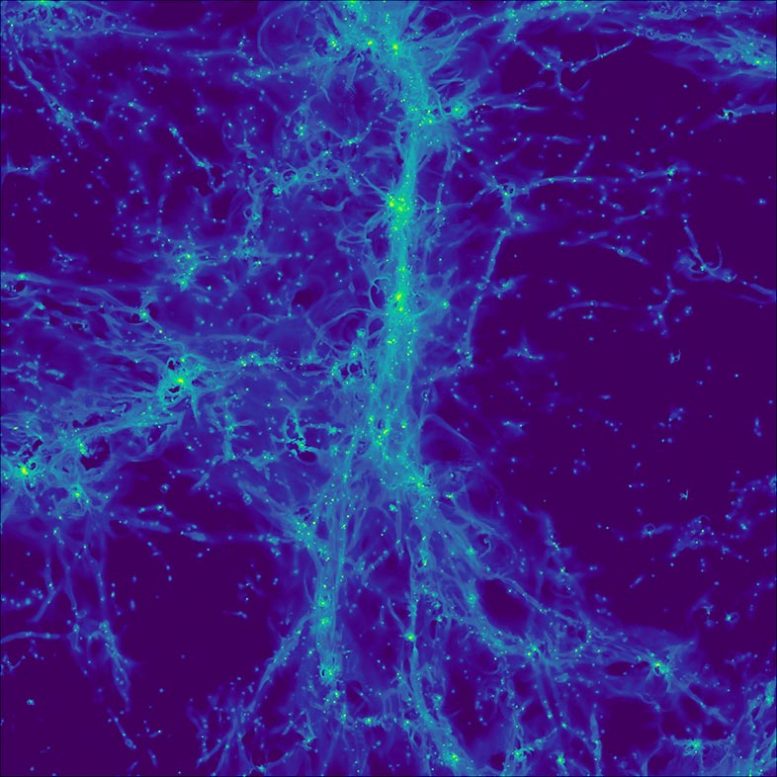
Figure 1: cosmological simulation of the distant Universe. The image shows the light emitted by hydrogen atoms in the cosmic web in a region roughly 15 million light-years across. In addition to the very weak emission from intergalactic gas, a number of point sources can be seen: these are galaxies in the process of forming their first stars. Credit: Jeremy Blaizot / projet SPHINX
- In the Universe, galaxies are distributed along extremely tenuous filaments of gas millions of light years long separated by voids, forming the cosmic web.
- The MUSE instrument on the Very Large Telescope has captured an image of several filaments in the early Universe…
- … revealing the unexpected presence of billions of dwarf galaxies in the filaments
Although the filaments of gas in which galaxies are born have long been predicted by cosmological models, we have so far had no real images of such objects. Now for the first time, several filaments of the ‘cosmic web’ have been directly observed using the MUSE[1] instrument installed on ESO’s Very Large Telescope in Chile. These observations of the early Universe, 1 to 2 billion years after the Big Bang, point to the existence of a multitude of hitherto unsuspected dwarf galaxies. Carried out by an international collaboration led by the Centre de Recherche Astrophysique de Lyon (CNRS/Université Lyon 1/ENS de Lyon), also involving the Lagrange laboratory (CNRS/Université Côte d’Azur/Observatoire de la Côte d’Azur),[2] the study is published in the journal Astronomy & Astrophysics.
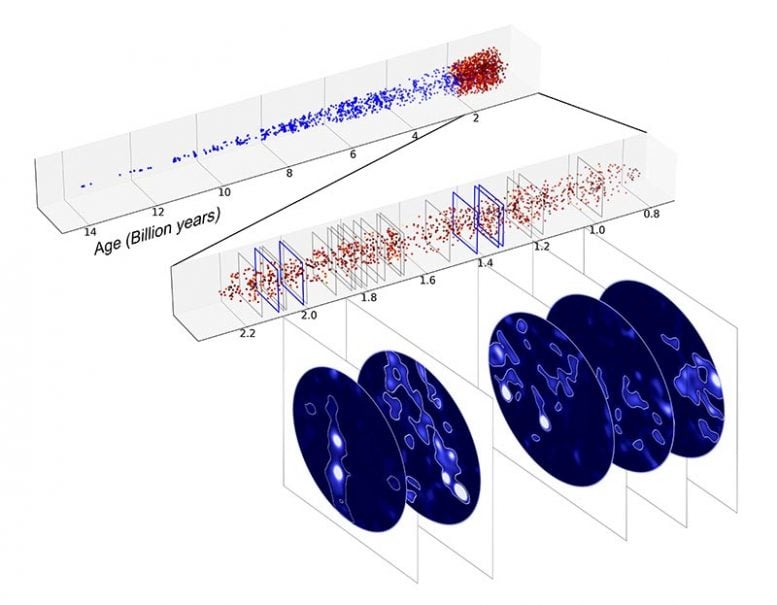
Figure 2: the 2250 galaxies in the ‘cone’ of the Universe observed by MUSE are shown here according to the age of the Universe (in billions of years). The period of the early Universe (0.8 to 2.2 billion years after the Big Bang) explored in this study is shown in red. The 22 regions with galaxy over-density are indicated by grey rectangles. The 5 regions where filaments have been identified most prominently are shown in blue. Credit: Roland Bacon / David Mary
The filamentary structure of hydrogen gas in which galaxies form, known as the cosmic web, is one of the major predictions of the model of the Big Bang and of galaxy formation [figure 1]. Until now, all that was known about the web was limited to a few specific regions, particularly in the direction of quasars, whose powerful radiation acts like car headlights, revealing gas clouds along the line of sight. However, these regions are poorly representative of the whole network of filaments where most galaxies, including our own, were born. Direct observation of the faint light emitted by the gas making up the filaments was a holy grail which has now been attained by an international team headed by Roland Bacon, CNRS researcher at the Centre de Recherche Astrophysique de Lyon (CNRS/Université Lyon 1/ENS de Lyon).
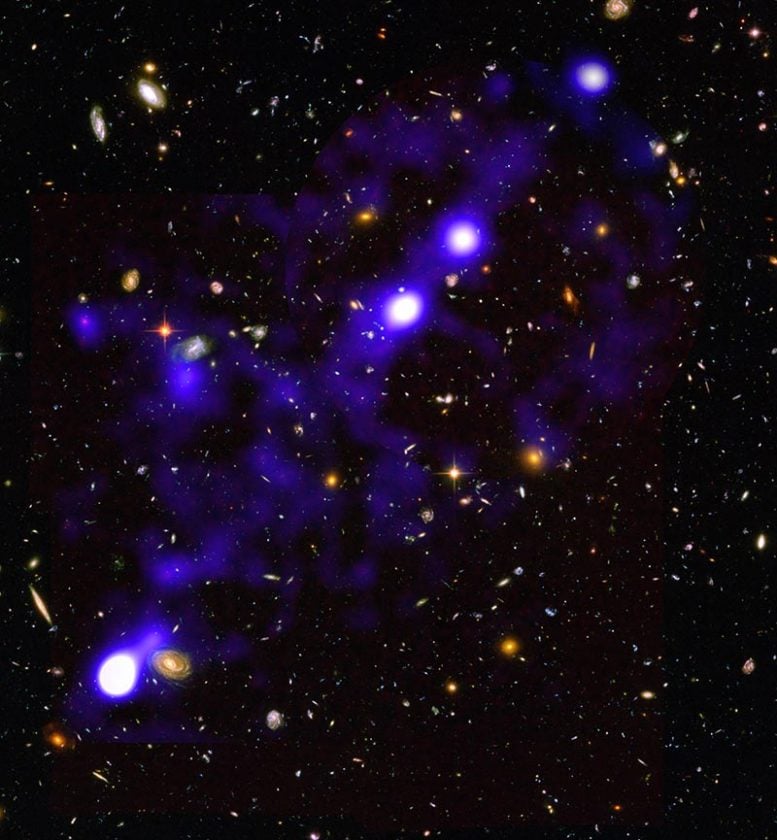
Figure 3: one of the hydrogen filaments (in blue) discovered by MUSE in the Hubble Ultra-Deep Field. It is located in the constellation Fornax at a distance of 11.5 billion light-years, and stretches across 15 million light years. The image in the background is from Hubble. Credit: Roland Bacon, David Mary, ESO and NASA
The team took the bold step of pointing ESO’s Very Large Telescope, equipped with the MUSE instrument coupled to the telescope’s adaptive optics system, at a single region of the sky for over 140 hours. Together, the two instruments form one of the most powerful systems in the world.[3] The region selected forms part of the Hubble Ultra-Deep Field, which was until now the deepest image of the cosmos ever obtained. However, Hubble has now been surpassed, since 40% of the galaxies discovered by MUSE have no counterpart in the Hubble images.
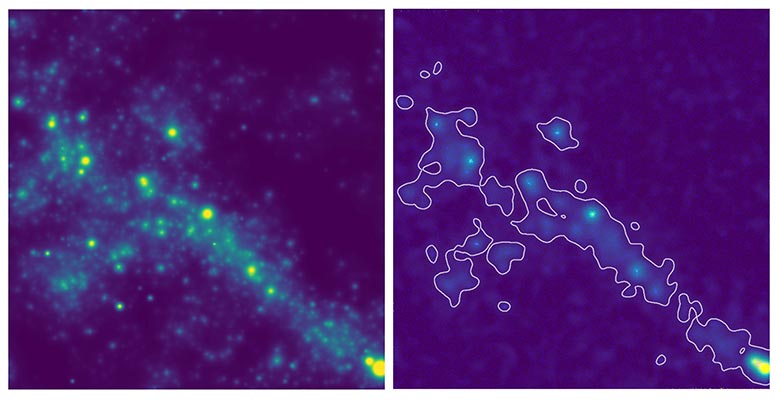
Figure 4: cosmological simulation of a filament made up of hundreds of thousands of small galaxies. The image on the left shows the emissions produced by all the galaxies as it might be observed in situ. The image on the right shows the filament as it would be seen by MUSE. Even with a very long exposure time, the vast majority of the galaxies cannot be detected individually. However, the light from all these small galaxies is detected as a diffuse background, rather like the Milky Way when seen with the naked eye. Credit: Thibault Garel and Roland Bacon
After meticulous planning, it took eight months to carry out this exceptional observing campaign. This was followed by a year of data processing and analysis, which for the first time revealed light from the hydrogen filaments, as well as images of several filaments as they were one to two billion years after the Big Bang, a key period for understanding how galaxies formed from the gas in the cosmic web [figures 2 et 3]. However, the biggest surprise for the team was when simulations showed that the light from the gas came from a hitherto invisible population of billions of dwarf galaxies spawning a host of stars [figure 4].[4] Although these galaxies are too faint to be detected individually with current instruments, their existence will have major consequences for galaxy formation models, with implications that scientists are only just beginning to explore.
Notes
- MUSE, which stands for Multi Unit Spectroscopic Explorer, is a 3D spectrograph designed to explore the distant Universe. The construction of the instrument was led by the Centre de Recherche Astrophysique de Lyon (CNRS/Université Claude Bernard-Lyon 1/ENS de Lyon).
- Other French laboratories involved: Laboratoire d’Astrophysique de Marseille (CNRS/Aix-Marseille Université/CNES), Institut de Recherche en Astrophysique et Planétologie (CNRS/Université Toulouse III – Paul Sabatier/CNES).
- See ESO press release.
- Until now, theory predicted that the light came from the diffuse cosmic ultraviolet background radiation (very weak background radiation produced by all the galaxies and stars) which, by heating the gas in the filaments, causes them to glow.
Reference: “The MUSE Extremely Deep Field: The cosmic web in emission at high redshift” by R. Bacon, D. Mary, T. Garel, J. Blaizot, M. Maseda, J. Schaye, L. Wisotzki, S. Conseil, J. Brinchmann, F. Leclercq, V. Abril-Melgarejo, L. Boogaard, N. F. Bouché, T. Contini, A. Feltre, B. Guiderdoni, C. Herenz, W. Kollatschny, H. Kusakabe, J. Matthee, L. Michel-Dansac, T. Nanayakkara, J. Richard, M. Roth, K. B. Schmidt, M. Steinmetz, L. Tresse, T. Urrutia, A. Verhamme, P. M. Weilbacher, J. Zabl and S. L. Zoutendijk, 18 March 2021, Astronomy & Astrophysic.
DOI: 10.1051/0004-6361/202039887



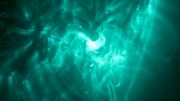




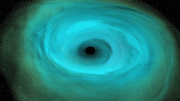
“We find that Lyα fluorescence powered by the cosmic UV background can explain at most 28−34% of the observed signal atz ≈ 3, and less than 10% atz ≈ 4.5 (Sect. 5.1.1).”
“… we show that the majority of the diffuse flux is due to the Lyα emission within the CGM of undetected galaxies and that only a small fraction can be coming from the IGM proper.”
“This first detection of the cosmic web structure in Lyα emission in typical filamentary environments, namely outside massive structures typical of web nodes, is a milestone in the long search for the cosmic web signature at high z.”
[ https://www.aanda.org/articles/aa/pdf/2021/03/aa39887-20.pdf ]
“atz [twice]” := at z.
Billions of galaxies with billions of stars each, means billions and billions of planets and they got to be definitely life on some of them. We can’t be alone. It is simply mind-boggling. Remember these are galaxies that were born way before hours and have existed many years before us.
.
Very interesting, but, in terms of the dwarf galaxies, we are just talking about the results of a simulation, not verified fact:
“ However, the biggest surprise for the team was when simulations showed that the light from the gas came from a hitherto invisible population of billions of dwarf galaxies spawning a host of stars [figure 4].[4] Although these galaxies are too faint to be detected individually with current instruments, their existence will have major consequences for galaxy formation models, with implications that scientists are only just beginning to explore.”
.
? “There are many dwarf galaxies in the Local Group; these small galaxies frequently orbit larger galaxies, …” [ https://en.wikipedia.org/wiki/Dwarf_galaxy ]
Hey! let’s spend our time, energy and resources looking outward instead of looking at our own planet. Then we can spew tons of CO2 into the atmosphere with rockets, find a new planet to invest then do it all over again.
Yes, lets use science to look everywhere since it is all mutually reinforcing! It certainly is better than an ill informed attempt that would hamper our understanding of nature and man made global warming – satellites and astronomical observation methods have been instrumental in understanding the problem.
And putting those satellites up hasn’t contributed significantly to the problem either. A 10 minutes launch using 1000s mt propellants is the equivalent of roughly 10 plane movements or roughly 1000 plane movements per year. But we see 5 billion passengers globally or 10 million global plane movements yearly (pre pandemic)!
We look to the past time, right? Those formations do not exist anymore, right?
It is past time. But the cosmic web filaments are still contracting and the web solidifying. (In the very distant future dark energy will rip those non-coherent structures apart.)
“In cosmology, galaxy filaments (subtypes: supercluster complexes, galaxy walls, and galaxy sheets)[1][2] are the largest known structures in the universe, consisting of walls of gravitationally bound galaxy superclusters. These massive, thread-like formations can reach 80 megaparsecs h−1 (or of the order of 160 to 260 million light-years[3][4]) and form the boundaries between large voids.[5]”
[ https://en.wikipedia.org/wiki/Galaxy_filament ]
Also note that most of the time (not in these figures though) it is the more massive dark matter web skeleton that is depicted.
Kinda off subject. But does anyone know of a theory that evolves around the expansion of our universe regarding everything getting farther away from us. But we get different measurements. So I was thinking what if it’s not expanding at all but rather everything in the universe losing mass slowly so everything we are looking at is actually getting smaller. Everything we see if slowly dying so why not be losing small amounts of mass all at the same time so yea we just all going to blip out.
Not really off subject, since the expansion of the universe is the process of the universe as a system and has made galaxies possible and the cosmic web so prominent. That century old cosmology is what is nowadays called the hot big bang and is part of the modern inflationary hot big bang cosmology (with the discovery that inflation preceded the hot big bang).
“There are a lot of people who mean “the initial singularity” when they say “the Big Bang,” and to those people, I say it’s long past due for you to get with the times. The hot Big Bang cannot be extrapolated back to a singularity, but only to the end of an inflationary state that preceded it.”
[ https://www.forbes.com/sites/startswithabang/2019/10/22/what-came-first-inflation-or-the-big-bang/?sh=147a17b54153 ].
Mass is energy in relativity, and energy can’t be lost. But it is a fact that the universe has passed its prime – star formation rate was highest 10 billion years ago – and that it is heading towards dilution and cooling – “heat death” [“Heat death of the universe”, Wikipedia].